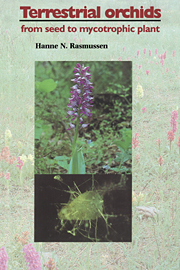Book contents
- Frontmatter
- Contents
- Acknowledgements
- Introduction
- 1 Properties of ‘dust’ seeds
- 2 Seed development
- 3 Seed survival
- 4 Requirements for germination
- 5 Fungi
- 6 Germination processes
- 7 Underground organs
- 8 Orchid mycorrhiza
- 9 Abiotic factors in growth and development
- 10 Life history and phenology
- 11 Propagation
- 12 Effects of orchid mycorrhiza
- 13 Descriptions of genera
- Appendix A Nutrient substrates mentioned in the text
- Appendix B Names and synonyms
- References
- Index
Introduction
Published online by Cambridge University Press: 13 October 2009
- Frontmatter
- Contents
- Acknowledgements
- Introduction
- 1 Properties of ‘dust’ seeds
- 2 Seed development
- 3 Seed survival
- 4 Requirements for germination
- 5 Fungi
- 6 Germination processes
- 7 Underground organs
- 8 Orchid mycorrhiza
- 9 Abiotic factors in growth and development
- 10 Life history and phenology
- 11 Propagation
- 12 Effects of orchid mycorrhiza
- 13 Descriptions of genera
- Appendix A Nutrient substrates mentioned in the text
- Appendix B Names and synonyms
- References
- Index
Summary
Background
Surely no plant group surpasses the orchid family in its appeal to scientific curiosity and imagination. The untiring professional and public interest in the Orchidaceae is reflected in a considerable number of volumes published each year on orchids; in particular, the great structural variety in the orchid flower is well represented in the literature.
Compared with the floristic study of this large and taxonomically complex group, other types of investigation lag behind. Of the many unusual features that can be noted in the orchid family their mode of life in association with fungi has probably attracted the least attention, which is surprising since it is without doubt a fundamental aspect of orchid biology.
The orchid family is the only large group of higher plants that makes consistent use of an alternative nutritional system. Orchid mycorrhiza differs from other major types of mycorrhiza in that the fungus supplies the plant with energy. During some of its life stages the orchid can rely entirely on mycotrophy for nutrition, while during other stages the plant makes use of both mycotrophy and phototrophic nutrition, either alternately or the one supplementing the other.
The great diversity of orchid habitats, which include places where paucity of soil or light precludes most plant life, is best understood in the context of orchid mycotrophy. In fact, many of the outstanding features of the orchids, such as the complexity of floral structures, the diversity of plant–pollinator interactions and the unusual characteristics of the seeds, can all be viewed as functional adaptations in relation to or dependent on the mycotrophic lifeform (Chapter 12). This in itself justifies a treatise on orchids centred on their mycorrhiza.
- Type
- Chapter
- Information
- Terrestrial OrchidsFrom Seed to Mycotrophic Plant, pp. 1 - 6Publisher: Cambridge University PressPrint publication year: 1995



